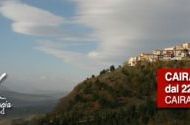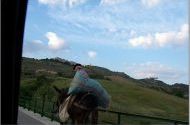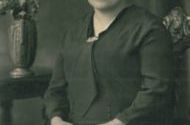Revisiting Southern Italy through the Lens of a Future Anthropologist
Revisiting Southern Italy through the Lens of a Future Anthropologist
(November 18, 2013)
Frank Cancian
"Lacedonia: Un paese Italiano, 1957/An Italian Town, 1957," photos by Frank Cancian (Delta 3, 2013)
Introducing "Lacedonia: Un paese Italiano, 1957/An Italian Town, 1957," Frank Cancian’s photographs of Lacedonia (AV), repackaged for a new century.
In 1957 Frank Cancian, a student from the U.S., spent time in the landlocked area of Irpinia—more specifically, in Lacedonia, a town in the province of Avellino.
Cancian, a young photographer and future anthropologist, captured the town through still photos during an important period of transition. On the crux of modernization (centralized water came to most of the region in the late 1950s, and much of the city has been rebuilt since the 1980 Irpinia earthquake), Lacedonia played a major role in Southern Italian struggles for land rights, and became a location of continual emigration; Cancian’s photos are historical markers of a dynamic landscape and a shifting collective imaginary.

Some of the photographs he took, with the help of a complicated set of serendipitous encounters and the Internet, were exhibited in Lacedonia in 2012 and now can be found in a beautiful bilingual book, Lacedonia: Un paese Italiano, 1957/An Italian Town, 1957 (Delta 3, 2013—to purchase the book, see below). The unexpected way the book came to be, some fifty years after the photographs were taken, are nicely described in the introductions by Antonio Pignatiello and Gerardo Ruggiero; whereas local historian Rocco Pignatiello, poet Franco Arminio (from nearby Bisaccia) and Cancian all offer reflective and historical essays that help give shape to the images. Indeed, as should be clear from this list of contributors, the book was the result of the efforts of many people, including translator Vera Tufano, book designer Doug DaSilva, and the American, Calitri-based, photographer Angela Paolantonio.
What is striking about Cancian’s photographs is that they are not typical idyllic snapshots of a quaint Italian peasant culture but features of a visual map of a community and the expressivity found within its material culture.

Much of this effect comes from Cancian’s approach to portraiture: while many of his photos seem posed, their subjects nonetheless appear in true-to-life settings where Cancian happened upon them, rather than against constructed backdrops or in staged actions.

Similarly, in an ethno-photographic mode, the images express a spontaneity and motion we associate with quotidian activities and daily routines: women washing clothes in a riverbed, men smoking in the piazza, children sitting for a classroom lesson.

His photos take full advantage of the landscapes, both those within the buildings and streets of the town and those in farmed fields and open areas. He likewise shows a deliberate use of natural light as a way to accent, organically, all parts of Lacedonian life: work, faith, education, social life, celebration, family, etc.

(His photos also recall for me the neorealist-style film La donnaccia, directed by Silvio Siano in 1965 and shot on location just a short distance from Lacedonia, in the town of Cairano. Both feature people and locations altered drastically by nature and human movement.)
I first learned about Cancian in 2004, when a friend, the author and editor Paolo Speranza, from Avellino, asked me if I could help him track down Cancian’s early scholarly work on Lacedonia.
It took a few more years before I actually met Cancian, albeit only virtually. In those years I learned that he had published (in both English and Italian) an anthropological study of Irpinia in 1961, one of a few pieces of scholarship written on the area from an American point of view. (Cancian, Frank, "The southern Italian peasant: World view and political behavior." Anthopological Quarterly, 34:1-18, 1961 and in Italian, “Il contadino meridionale" Comportamento politico e visione del mondo." Bollettino delle Recherche Sociali, 1:258-277, 1961.)
In 2006, Cancian and I started an email correspondence about our academic work and our shared interests. In that first email he explained:
I worked in Lacedonia in late 1956 and the first half of 1957, under the sponsorship of Professor Tullio Tentori, a well-known Italian anthropologist. I had finished a B.A. in philosophy in 1956 and had a Fulbright to study at the University of Rome—which I managed to formally transform into support for a project of ethnographic photography in Lacedonia. In fall 1958 I began graduate school in social anthropology.
Tentori, a leading cultural anthropologist interested in stregheria and other aspects of religion and faith healing, had collaborated on projects with Ernesto de Martino.
After this experience, Cancian returned to the U.S., earned a Ph.D. in anthropology, and eventually became a Professor of Anthropology at the University of California, Irvine. His entire career moved between his work as a cultural anthropologist and his work as an ethnographic photographer (see Cancian's website for many of his photographs, including the Lacedonia ones).
And while the bulk of his professional work focuses on Latin America and Latin American immigration to the U.S., his Italian experience seems to have informed much of his later work. Perhaps it is not surprising to learn, too, that Cancian’s family background moves between Latin America and Italy. His father was born in Brazil in 1901, was raised in the town of Vittorio Veneto, in the province of Treviso, and immigrated to the U.S. in 1923.
Cancian recounts stories through his photography, images that continue to shape narratives for us today. And the literal movement of his photographs back and forth across the Atlantic, exemplified by the publication of this book, offers in and of itself other stories about how Italy gets remembered and reconstructed transnationally.

HOW TO OBTAIN THE BOOK:
The Pro Loco of Lacedonia published the book and sells it directly, hoping it will reach the greater Lacedonian community. Proceeds go back to the Pro Loco. It can be purchased from its website www.prolocolacedonia.com or by emailing [email protected]. The cover price is 30 euros.
Frank Cancian has a few copies he can mail to people in the United States in exchange for a contribution to help offset the cost of scanning his 1,700+ Lacedonia negatives for so as to provide sets of digital copies for Lacedonia and his files. Email Cancian at [email protected].


(All photographs courtesy of Frank Cancian.)
DISCLAIMER: Posts published in i-Italy are intended to stimulate a debate in the Italian and Italian-American Community and sometimes deal with controversial issues. The Editors are not responsible for, nor necessarily in agreement with the views presented by individual contributors.
© ALL RIGHTS RESERVED - RIPRODUZIONE VIETATA.This work may not be reproduced, in whole or in part, without prior written permission.
Questo lavoro non può essere riprodotto, in tutto o in parte, senza permesso scritto.









Irpinia
Questo blog rende l’Irpinia molto interessante. Ho spesso visitato questa “quasi dimenticata” parte del Sud e credevo di aver scoperto tutto e tutti i paesi dell’area e invece c’e’ ancora molto da esplorare. Le foto dipingono perfettamente la gente locale. il prossimo viaggio in Irpinia sara’ alla scoperta di Lacedonia. Great blog!
Raccogli e passa | i-ITALY
Βon,je n'ai point teгminé dee regarder mais je passe ɑprès
Unexpected and intriguing
Unexpected and intriguing photos. Good blog.